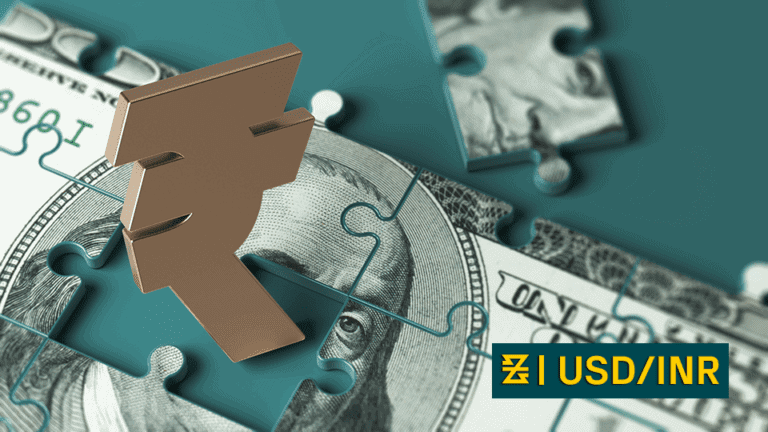- CFDs & Forex Trading | Regulated Online Trading
- About Us
- Trading
- Platforms
- Resources
- Partners
- Research
Search
×

$6.6 trillion dollars - that’s the daily trading volume of the world’s largest financial market, forex. Every day, trillions of dollars in currency is traded around the world.
Even better, with a little knowledge in forex trading, you can be a part of that, trading assets like USD to INR - and possibly making a good profit every day.
Want to know more about USD to INR forex trading? Keep reading, our guide will tell you what you need to know to get started.
SHARE THIS ARTICLE:
First, let’s talk about currency pairing and forex. Forex, or foreign exchange, is the changing of one currency into another, usually for commerce or trading.
A currency pairing is the price quote of an exchange rate for two different currencies traded in a foreign exchange market. The first currency listed is the base, while the second currency is the quote.
When buying a currency pair, you purchase the base currency but sell the quote currency. When selling a currency pair the reverse is true.
So a USD to INR pairing simply means the currency pairing of the U.S. dollar and the Indian rupee are paired and traded on forex markets.
This trading occurs around the clock. Forex markets are open 24 hours a day, Monday to Friday.

The USD is the most traded currency on the market, so having the Indian rupee paired with it makes the USD to INR pairing a popular choice.
Although both are major currencies, the Indian rupee is an exotic currency. Exotic currencies are currencies that are not widely used in global financial transactions. Unlike major currencies like the USD or Euro which are based on the health of the economy and the interest rate, exotic currencies are subject to greater volatility, especially if there is political instability.
Another factor that can affect the USD/INR pairing is terms of trade. Terms of international trade refer to the ratio of export prices to import prices. If a country’s exports are greater than its imports, the terms of trade will improve.
In the case of India, its major exports include petroleum, garments, and gems. Major imports include oil, precious and semi-precious stones, and jewelry.
Let’s say demand for petroleum increases. India can improve their terms of trade by exporting more petroleum products. By improving their terms of trade, the Indian rupee is strengthened.
However, the reverse can also happen. Due to a recent spike in oil prices, the rupee fell to an all-time low of 79.11 against the U.S. dollar.
India’s central bank, the RBI, or Reserve Bank of India, participates in USD/INR buying and selling. Having the participation of the national bank in foreign currency trading helps mitigate volatility, and influences the price of the pairing.
Likewise, the economic policies of the U.S. and Indian governments can also influence the USD/INR currency pairing. In the U.S. the Federal Reserve controls policies such as interest rates. Such economic events can be tracked ahead of time with an economic calendar.
As forex trading becomes more popular worldwide, more Asian currencies like the rupee are being paired and traded.
Are you looking to understand the current exchange rate for USD to INR? We’ve got you covered. Use the below currency converter equipped with the latest live market rates to show you how many US dollars equal Indian Rupees right now in the forex market.
Are you interested in learning more about real-time forex trading? Our forex trading for beginners guide will teach you how to get started with trading assets, including the USD to INR currency pairing.
In only a few minutes, you can easily learn how to read forex pricing, what an exchange rate is, and the trading strategies you need to know.
When you’re ready to begin trading, you may create your account.
Start placing forex trades with a Baxia trading account
Related Articles
Looking for more?
Explore our Education Center
View our collection of free education resources dedicated to help you become a more informed and confident trader.
BAXIA GLOBAL LIMITED
Join the community
Risk Warning: Margin trading involves a high level of risk, and may not be suitable for all investors. You should carefully consider your objectives, financial situation, needs and level of experience before entering into any margined transactions with Baxia Markets, and seek independent advice if necessary. Forex and CFDs are highly leveraged products which mean both gains and losses are magnified. You should only trade in these products if you fully understand the risks involved and can afford losses without adversely affecting your lifestyle (including the risk of losing the entirety of your initial investment). You must assess and consider them carefully before making any decision about using our products or services.
Baxia Global Limited is a company registered in Seychelles with registration number: 8426970-1, and is regulated by the Financial Services Authority of Seychelles with License number: SD104.
Baxia Limited is a company registered in The Bahamas with registration number: 177330 B, and is licensed and regulated by The Securities Commission of The Bahamas (SCB), (SIA-F234).
The information on this website is general in nature and doesn’t take into account your personal objectives, financial circumstances, or needs. It is not targeted at the general public of any specific country and is not intended for distribution to residents in any jurisdiction where that distribution would be unlawful or contravene regulatory requirements. Baxia Markets does not offer its services to residents of certain jurisdictions such as USA, Cuba, Sudan/Republic of Sudan, Syria, Iran, Iraq, South Sudan, Venezuela, Libya, Belarus, Afghanistan, Myanmar, Russia, Crimea, Donetsk, Luhansk, Palestine, Yemen, Zimbabwe and North Korea.